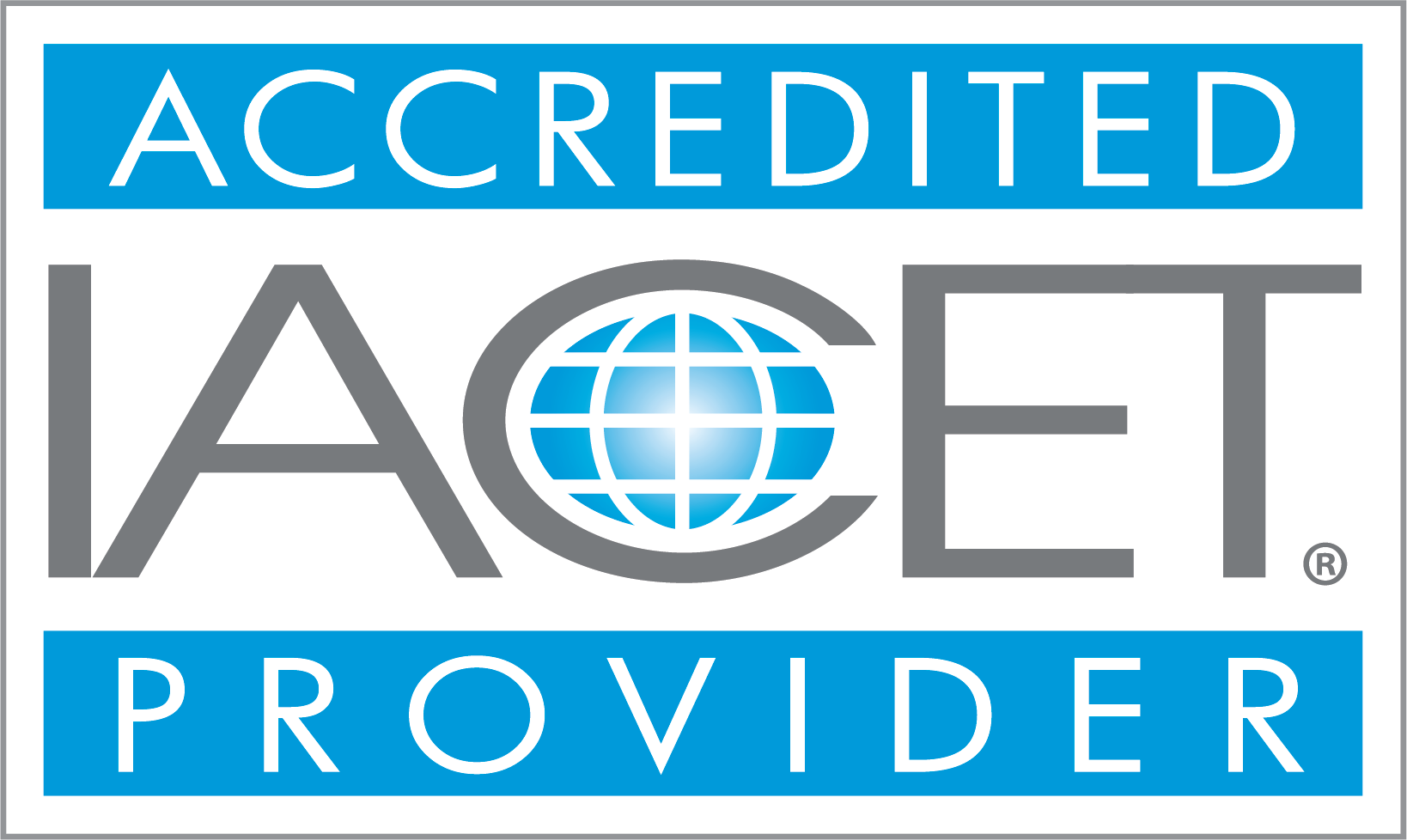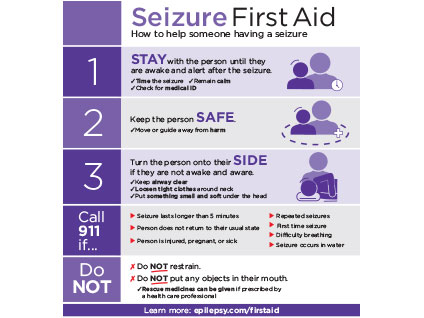Seizure First Aid Training and Certification
Seizure Recognition and First Aid Certification
The Seizure Recognition and First Aid certification training provides information to increase the knowledge, skills and confidence in recognizing seizures and safely administering seizure first aid. The first aid procedures in the course reflect the standard of knowledge and current best practices. Participants who successfully complete the course will receive a two-year certification. The course lasts approximately 90 minutes.
There are two ways you can get Seizure First Aid certified:
- On-Demand - Access the On-Demand course now.
- National Live, Instructor-Led - Sign up for one of the scheduled classes below
- April 2nd, 2024, at 4:00 p.m. ET in recognition of National Public Health Week in partnership with the APHA Public Health Education and Health Promotion Section
- May 7th, 2024, at 4:00 p.m. ET in recognition of Asian American and Pacific Islander Heritage Month
- June 4th, 2024, at 4:00 p.m. ET
- June 20th, 2024, at 1:00 p.m. ET instruction delivered in Spanish - CLICK HERE TO REGISTER
Remember #StaySafeSide for seizure first aid.
"Get seizure first aid trained!"
Seizure First Aid Ready
Access this 30-minute online training from anywhere, anytime. Seizure First Aid Ready educates the public on the Epilepsy Foundation’s basic procedures for responding to someone having a seizure. The on-demand course is presented in an interactive format with animations, videos, and activities to help everyone become Seizure First Aid ready.
Participants who successfully complete the training will receive a certificate of completion. This is not a certification course.
Learn More:
Register for a Seizure First Aid Course TodayYou will be directed to the Epilepsy Learning Portal where you can create an account and access one of our seizure first aid trainings. For Spanish courses, visit aprende.epilepsy.com.
In addition, in accordance with CDC, state and local health guidelines many local Epilepsy Foundation offices offer Seizure Recognition & First Aid Certification live instructor-led trainings.
Why Is Seizure First Aid Important?
Knowing how to help someone during a seizure can make a difference and save a life. While there are many different types of seizures, people who experience seizures may be confused, not aware of what is going on, or unconscious. A person could get hurt during a seizure, a seizure could last too long, or the seizures could cluster.
Who Should Be Seizure First Aid Certified?
While everyone should know basic seizure first aid, becoming seizure first aid certified takes you further. You will learn about epilepsy, how to recognize signs of a seizure, how to use basic seizure first aid steps, and when emergency medical help is needed.
Seizure First Aid Certification is designed for people who:
- Have a family member, loved one, or friend with seizures
- Have a job where you provide care for people with seizures
- Have a job where you work with the public or work with someone who has seizures
- Coach or lead groups
Are Continuing Education Units Available?
The Seizure Recognition & First Aid Certification training is also available to those wanting to obtain continuing education units. Sponsored by the Epilepsy Foundation, a designated provider of continuing education contact hours (CECH) in health education by the National Commission for Health Education Credentialing, Inc.
This program is designated for Certified Health Education Specialists (CHES) and/or Master Certified Health Education Specialists (MCHES) to receive up to 1.5 total Category I contact education contact hours. Maximum advanced-level continuing education contact hours available are 0. Provider ID#: 121739
For additional information please contact the Epilepsy Foundation Public Health and Education Team at programs@efa.org.
IACET Continuing Education Units (CEUs)

As an IACET Accredited Provider, the Epilepsy Foundation offers IACET Continuing Education Units (CEUs) for its learning events that comply with the ANSI/IACET Continuing Education and Training Standard. Accreditation #: 5660372-1
Total Contact Hours: 1.1
Total IACET CEUs Awarded: .1
General First Aid for All Seizure Types
The first line of response when a person has a seizure is to provide general care and comfort and keep the person safe. The information here relates to all types of seizures. Find specific steps for responding to different seizure types here.
Remember
For most seizures, basic seizure first aid is all that is needed. The steps are simple - Stay. Safe. Side - anyone can do them.
Download the Seizure First Aid Poster

Our Seizure First Aid poster is available in several languages for your convenience. Please view the list below to find the language of your choice.
What should I do when someone has a seizure?
STAY with the person and start timing the seizure.
- Remain calm – it will help others stay calm too. Talk calmly and reassuringly to the person during and after the seizure – it will help as they recover from the seizure.
- Check for medical ID.
- Look at your watch and time the seizure from beginning to the end of the active seizure.
- Timing the seizure will help you determine if emergency help is needed.
- While most seizures only last a few minutes, seizures can be unpredictable. Some may start with minor symptoms but lead to loss of consciousness or a fall that could cause injury. Other seizures may end in seconds.
Keep the person SAFE.
- Move or guide away from harmful or sharp objects.
- If a person is wandering or confused, help steer them clear of dangerous situations. For example, gently guide them away from traffic, train or subway platforms, heights, or sharp objects.
- Encourage people to step back and give the person some room. Waking up to a crowd can be embarrassing and confusing for a person after a seizure.
- Ask someone to stay nearby in case further help is needed.
Turn the person onto their SIDE if they are not awake and aware.
- Make the person as comfortable as possible.
- Loosen tight clothes around neck.
- If they are aware, help them sit down in a safe place.
- If they are at risk of falling or having a convulsive seizure or tonic-clonic seizure:
- Lay them down on the floor.
- Put something small and soft under the head.
- Turn them on their side with their mouth pointing toward the ground. This prevents saliva from blocking their airway and helps the person breathe more easily.
- During a convulsion, it may look like the person has stopped breathing. This happens when the chest muscles tighten during the tonic phase of a seizure. As this part of a seizure ends, the muscles will relax and breathing will resume normally.
- Rescue breathing is generally not needed during these seizure-induced changes in a person’s breathing.
Do NOT put any objects in their mouth.
- Don't put any objects like a spoon, stick or wallet into a person's mouth.
- Don’t worry – a person can’t swallow their tongue during a seizure.
- Jaw and face muscles may tighten during a seizure, causing the person to bite down. If this happens when something is in the mouth, the person may break and swallow the object or break their teeth!
- Rescue medicines that are placed inside the cheek can be given if recommended by their health care team.
- Don't give water, pills or food to swallow until the person is awake. Food, liquid or pills could go into the lungs instead of the stomach if they try to drink or eat when not fully aware.
Do NOT restrain.
- Trying to stop movements or forcibly hold person down doesn’t stop a seizure.
- Restraining a person can lead to injuries and make the person more confused, agitated, or aggressive. People don’t fight on purpose during a seizure. Yet if they are restrained when they are confused, they may respond aggressively.
- If a person tries to walk around, let them walk in a safe, enclosed area if possible.
STAY with them until they are awake and alert after the seizure.
- Most seizures end in a few minutes.
- Injury can occur during or after a seizure, requiring help from other people.
- If a person appears to be choking, turn them on their side and call for help. If they are not able to cough and clear their air passages on their own or are having breathing difficulties, call 911 immediately.
- Be sensitive and supportive. Ask others to do the same.
- Seizures can be frightening for the person having one, as well as for others. People may feel embarrassed or confused about what happened. Keep this in mind as the person wakes up.
- Reassure the person that they are safe.
- Once they are alert and able to communicate, tell them what happened in very simple terms.
- Offer to stay with the person until they are ready to go back to normal activity or call someone to stay with them.
When to Call for Emergency Help
- Seizure lasts longer than 5 minutes
- Repeated seizures
- Difficulty breathing
- Seizure occurs in water
- Person is injured, pregnant, or sick
- Person does not return to their usual state
- First time seizure
- The person asks for medical help
Visit Our Online Store
We also have posters, pamphlets, bookmarks, and more on seizure first aid in our online store. Many are available in both English and Spanish and through digital download.
Get the tools you need to raise awareness about seizure first aid.
Resources
Epilepsy Centers
Epilepsy centers provide you with a team of specialists to help you diagnose your epilepsy and explore treatment options.
Epilepsy Medication
Find in-depth information on anti-seizure medications so you know what to ask your doctor.
Epilepsy and Seizures 24/7 Helpline
Call our Epilepsy and Seizures 24/7 Helpline and talk with an epilepsy information specialist or submit a question online.
Tools & Resources
Get information, tips, and more to help you manage your epilepsy.



